- Home
- Mark Twain
Connecticut Yankee in King Arthur's Court (Barnes & Noble Classics Series) Page 2
Connecticut Yankee in King Arthur's Court (Barnes & Noble Classics Series) Read online
Page 2
A Connecticut Yankee in King Arthur’s Court may be the world’s first novel about time travel. It certainly has the most fantastic plot of all Twain’s fictions. But the inspiration to send a modern American through time as well as space sprang directly out of Twain’s long-standing literary goals. The story of the story begins on a Saturday in December 1884, with Twain traveling around the country on a reading tour to promote Huck Finn. In a bookstore in Rochester, New York, George Washington Cable, his fellow novelist and partner on the tour, suggested that Le Morte d’Arthur (The Death of Arthur), Sir Thomas Malory’s classic romance about the knights of the Round Table, would make good reading matter for the trip. Twain bought the book, began reading it the next day, and shortly afterward made a note in his journal about an idea for a sketch:
Dream of being a knight errant in armor in the middle ages. Have the notions & habits of thought of the present day mixed with the necessities of that. No pockets in the armor. No way to manage certain requirements of nature. Can’t scratch. Cold in the head—cant blow—can’t get a handkerchief, can’t use iron sleeve.
The emphasis here is on the idea’s comic possibilities. The literary goal Twain’s audience always expected him to put first was making them laugh. As a professional humorist, he learned early that people are much more likely to laugh when they’re nervous or uncomfortable. Sex, for example, that staple of modern stand-up, is not inherently funny, but it is a subject to which almost everyone attaches some degree of discomfort. The mores of Twain’s late-Victorian America ruled out sex as a subject; people laugh when they’re anxious, not when they’re offended or shocked. But the principle of making an audience uneasy enough to laugh applies to any subject in which they are emotionally over-invested, and his culture’s proprieties and evasions gave Twain many other opportunities to make his audience uneasy. One of his favorite strategies was treating something they considered sacred in a mocking or irreverent spirit. A knight in shining armor was a subject that you were supposed to approach on bended knees. If, while looking up at that knight, you notice his nose is running, the disequilibrium caused by this clash between the sacred and the profane, between what a culture enshrines and what it represses, will probably seek to discharge itself through laughter. The movie Monty Python and the Holy Grail proves that Camelot is still a target-rich environment for comedy to attack; and in Mark Twain’s time, when the standard for depicting the days of knights was set by elegiac works like Tennyson’s Idylls of the King (finished in 1885), the territory Twain works in the novel was even more vulnerable to burlesque and parody.
Twain never forgot that the job his readers paid him for was making them laugh, but that was only one of his literary goals. In an autobiographical dictation made near the end of his life, he explains how his achievement differs from that of “mere humorists” by asserting that “I have always preached.” As a text for a sermon, that dream of being a knight whose body itches in places he can’t reach points toward Twain’s project as an American realist. To Twain as a humorist, texts like Malory’s book were good things to make fun of, the “straight” resources he could exploit. But Twain also belonged to the generation of nineteenth-century novelists who defined their work as a revolt against the romance tradition. Giving that archetype of romance heroism, the knight in armor, the common “requirements of nature” exposes the ideal world of books to the real world of such things as bodily “necessities.” Hank’s favorite expletive throughout Connecticut Yankee is “Great Scott!” This is Twain’s way of keeping his narrative in dialogue with the medieval novels of Walter Scott, the British writer who, for him, epitomized the factitiousness of literary romance. Twain talks about Scott directly in Life on the Mississippi, where he makes it clear that his quarrel is not simply aesthetic. Scott, according to Twain, did “more real and lasting harm, perhaps, than any individual that ever wrote”; a book like Scott’s Ivanhoe was even “in great measure responsible” for the Civil War, because its unrealistic representations warped the minds of the white South away from “the genuine and wholesome civilization of the nineteenth century” and toward “the jejune romanticism of an absurd past that is dead.” (There is an echo of this charge in William Faulkner’s Absalom, Absalom!, where we’re told that the horse on which Sutpen rides off to the war got its name from a Scott novel.) What Twain says in Life about history anticipates the argument he puts into Hank’s mouth: that the true Reign of Terror was not the violence of the French Revolution, but the ancien regime, the centuries of aristocratic privilege and abuse—Hank calls it “a thousand years of such villainy” (p. 128). Because of enchanters like Malory, Scott, and Tennyson it is the past that “none of us has been taught to see ... as it deserves” (p. 128).
That is Hank’s job: to cure readers of what (in Life on the Mississippi) Twain calls “the Sir Walter disease” by teaching them to see the feudal realities left out of Scott’s account. At the start Hank tells us that he is “barren of sentiment” and “poetry” (p. 19). Thus he can serve as an accurate reporter on the medieval world that Scott represents by chivalrous heroes like Ivanhoe and beautiful heroines like Rowena. Alongside the “noble cavalcade” of plumed knights in chapter 1, for instance, Hank also sees “the muck, and swine, and naked brats ... and shabby huts” (p. 25), the reality of life for the common people of Arthur’s realm, the poverty, ignorance, injustice, and slavery that never get described in the ideal world romance creates. Having brought Hank across 1,300 years Twain takes him on two more trips, both through Arthur’s realm: first with Sandy (chapters 11-20), then with the King (chapters 27-38). The sights Hank sees on these travels—the tortured prisoners in Morgan le Fay’s dungeon, the impoverished peasant family dying of small-pox—work to disenchant readers of any nostalgia they might have felt for the mythic past.
As a means of establishing a realistic perspective on feudal England, Hank resembles Huck Finn, whom Tom Sawyer is always upbraiding for not having read any romances about noble robbers and suffering aristocrats. There are literal slaves in both Huck Finn and Connecticut Yankee, but both novels are perhaps most concerned with the form of mental enslavement that we can call ideological or cultural, that Hank himself calls “training”: the way that one’s perception of reality is shaped or determined by “inherited ideas,” by the values and prejudices of a particular time and place. Huck believes, for example, that slavery is right and that he is wicked to help Jim run toward freedom. The people of the sixth century believe in the legitimacy of slavery, too, and in magic and dragons, and in all kinds of other ideas that, to Hank’s eyes, seem equally irrational: the divine right of kings, for example, and the legitimacy of an established church. Twain’s larger concern, however, is with the idea of the past that his contemporary readers have inherited from romances. Hank’s unpoetic point of view is only one of the weapons Twain deploys against that idea. He also attacks it with bursts of righteous indignation, with sentimental scenes of peasant and slave mothers, and with humor that is often brilliantly outrageous, as when Sandy’s noble ladies are revealed to be a sty full of pigs—in—cluding “one small countess ... with hardly any hair on her back” (p. 200). Hank blows up Merlin’s tower, itself a relic of older times; Twain seeks to explode the fantasy of a nobler past. Hank brings electricity to Camelot, making it “the best electric-lighted town in the kingdom” (p. 430); Twain tries to illuminate the Dark Ages themselves.
And as an American realist, Twain has an additional stake in this revisionary project. Hank travels through space as well as time. The books Twain is rewriting, like the past Hank revisits, are European. American literature has always been postcolonial. The United States won political independence before the end of the eighteenth century, but cultural independence—in particular from the inferiority complex that all former colonies acquire—was something Twain knew his country still had to struggle for. Throughout the nineteenth century American writers felt that the long shadow cast by the achievements of European literature and art stunted their
own growth; their economic as well as artistic well-being was bound up with the question of whether American readers would agree with Emerson when, two years after Sam Clemens was born, he declared that “we have listened too long to the courtly muses of Europe.” In his nonfiction travel book The Innocents Abroad Twain himself goes east to the Old World and, as a typical American tourist, spends a lot of time in museums and cathedrals, dutifully looking at the works of the old masters. One reason Innocents Abroad was the best-selling of all his books among his contemporaries is that in it Twain defines a way of looking that enables an American to laugh at those idols of high culture and, by laughing, to knock the achievements of Europe off the pedestals from which they seemed to tower over anything an American could achieve. “I never felt so fervently thankful,” he writes in the middle of his account of traveling through Italy, “as I did yesterday when I learned that Michael Angelo was dead.” Connecticut Yankee’s most exuberant declaration of freedom from such old masters is probably the scene in chapter 39 of Hank as a cowboy, lassoing Sir Launcelot and dragging him off his horse.
In other words, as Twain had done in Innocents Abroad, in Connecticut Yankee Hank goes back east to vindicate the notion that as human progress moved forward through time it also moved westward in space, from a benighted Old World to a blessed new one. For Twain, the essence of the medieval past is not chivalry but slavery: “Any Established Church,” Hank writes, is “an established slave-pen” (pp. 154-155); “a privileged class, an aristocracy, is but a band of slaveholders under another name” (p. 256); the people of the sixth century are either “slaves, pure and simple,” or “slaves in fact, [though] without the name” (p. 79). By contrast the New World, the nineteenth-century America from which Hank comes, is defined by freedom of religion, a democratic political system, the free enterprise of capitalism, the free inquiry of the scientific method. In Life on the Mississippi, Twain calls the present moment “the plainest and sturdiest and infinitely greatest and worthiest of all the centuries the world has seen.” When he looks at the past through Hank’s eyes, everything he sees seems to confirm that faith.
At least that is the way Connecticut Yankee was read in its time. “A book that appeals to all true Americans,” “a book that every man, woman, and child in this country should read and be proud of,” “thoroughly patriotic”—so claimed the ads for the novel in 1889. It was brought out by the publishing company that Twain himself owned, and so he had complete control over how it was advertised and promoted. Potential buyers were promised a celebration of modern American superiority to old England, and if the reactions of contemporary reviewers are representative, that is what they got. English reviewers condemned the novel as “a vulgar travesty,” an unfunny and irreverent desecration of a noble tradition. All but one of the American reviews I have found were enthusiastic about its cultural politics. Twain’s friend and fellow realist William Dean Howells called it “an object-lesson in democracy,” American humor “employed in the service of humanity.” “Mark Twain has come up from the people,” said a paper in California, is “American to the backbone,” and has written a “bright and witty” satire on England. One Boston reviewer even noted that as examples of “the advance in popular bookmaking,” the novel’s illustrations offered yet more proof of American progress. The only negative American review agreed that the novel’s aim was “the glorification of American democracy,” but protested that it failed “through [its] extreme partiality” to Hank’s smugly modern and nationalistic perspective.
Whether or not they shared that perspective, the reviewers were sure Twain did. No contemporaries were tempted to read the novel’s first-person narrative as ironic or unreliable. Twenty-first-century readers are likely to have a more complex response, and not just because our postmodern sensibility is so attuned to irony. Because in effect we must travel back a dozen decades to read Hank’s story, we are in somewhat the same outsider’s position in relation to him that he occupies in the sixth century. We can see what he is blind to: the way his training reflects the preconceptions and beliefs of his time and place. Once he realizes the leverage his thirteen-century head start gives him on the primitive world he finds himself in, Hank sets out to reform and enlighten the Dark Ages. Having come from a factory, he equates progress with industrialization. He calls his system of schools “Man-factories.” There’s no mistaking the pride in his voice when he tells us in chapter 10, “In various quiet nooks and corners I had the beginnings of all sorts of industries under way—nuclei of future vast factories, the iron and steel missionaries of my future civilization” (p. 95). If we listen closely, we can hear his unexamined faith right alongside his pride: That word “missionaries” indicates that he believes in technology as devoutly as the Arthurians believe in magic. To him, just as the great inventors like Gutenberg and Bell are “the creators of this world—after God” (p. 342), so the machines they invented can save the world from its ills. The patent office Hank sets up as his first action as the King’s minister is his equivalent to a cathedral.
Late-nineteenth-century America was one of the great ages of mechanical invention, and Hank’s faith in industrialization and progress was widely shared: A great many city seals designed in this period used factories with smokestacks pouring out black smoke as the symbol of growth. But as the novel itself progresses, it puts a lot of pressure on Hank’s uncritical belief in technology. We may hardly notice the metaphor with which, in chapter 10, he concludes his boast about the “Beginnings of Civilization”:
My works showed what a despot could do with the resources of a kingdom at his command. Unsuspected by this dark land, I had the civilization of the nineteenth century booming under its very nose! ... There it was, as sure a fact, and as substantial a fact as any serene volcano, standing innocent with its smokeless summit in the blue sky and giving no sign of the rising hell in its bowels (pp. 97-98).
When he tells us about the smoky success of his soap factory in chapter 16, however, the irony is harder to overlook. Like a great many American travelers to Europe, Hank is appalled at the natives’ lack of hygiene, and he uses their inability to realize how dirty they are as further proof of the numbing effects of training. Since Hank knows that cleanliness is next to godliness, he sets up a factory to manufacture soap at the castle in Camelot, and sends the knights of the Round Table out to peddle it to the populace.
My soap factory felt the strain early ... running night and day; and the atmospheric result was getting so pronounced that the king went sort of fainting and gasping around ... and Sir Launcelot got so that he did hardly anything but walk up and down the roof and swear, although I told him it was worse up there than anywhere else (p. 155).
“It,” of course, is air pollution. While the soap removes the dirt from people’s bodies, the factory belches dirt into the air they breathe, but just as only Hank objects to their uncleanliness, so only the Arthurians complain about the damage the factory is doing to the environment. We may look at both and see not just how dirt remains a fact of life in either case but also how completely conditioned are both sixth-century Britons and the nineteenth-century American, how completely reality for them all has been defined by what their training has taught them to see or not see.
Hank’s blind faith in technology never wavers, not even when one of its shiniest new inventions turns the “Valley of Holiness” into the “Valley of Hellishness.” That happens in chapter 24, when Hank discovers that technicians from one of his Man-factories have secretly installed a telephone in a cave in the valley where he has just had one of his most spectacular public triumphs, making a fountain flow again and convincing the locals to bathe in its waters. Finding this symbol of progress in a cave once occupied by a hermit is for Hank, according to his own language, a religious sign:
Now what a radical reversal of things this was; what a jumbling together of extravagant incongruities; what a fantastic conjunction of opposites and irreconcilables—the home of a bogus miracle become the home o
f a real one, the den of a medieval hermit turned into a telephone office! (p. 246).
The technician operating the phone is equally surprised to see Hank, having been told over the newly established telephone line that Hank’s triumph at the “Valley of Holiness” happened in a place called the “Valley of Hellishness.” Hank realizes it was a problem with static on the line: “Confound a telephone, anyway. It is the very demon for conveying similarities of sound that are miracles of divergence from similarity of sense” (p. 247). The repetition of the word “miracle” reverses or at least complicates its sense. Is technology a divine or a demonic “miracle”? What world is Hank creating by industrializing the sixth century—a holy or a hellish one?

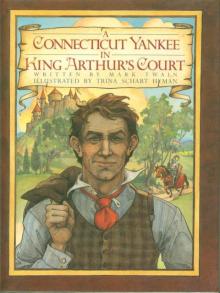 A Connecticut Yankee in King Arthur's Court
A Connecticut Yankee in King Arthur's Court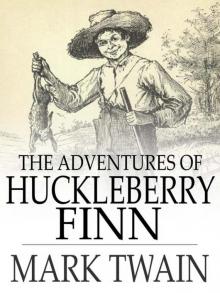 Adventures of Huckleberry Finn
Adventures of Huckleberry Finn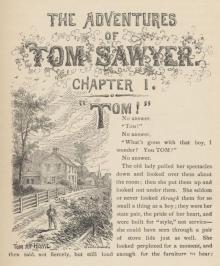 The Adventures of Tom Sawyer, Part 1.
The Adventures of Tom Sawyer, Part 1.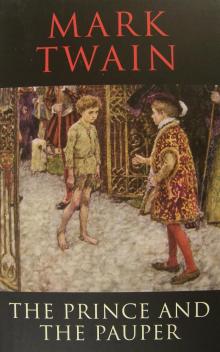 The Prince and the Pauper
The Prince and the Pauper The American Claimant
The American Claimant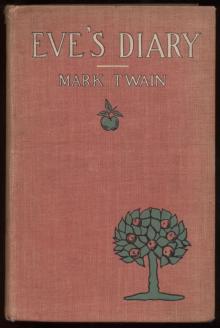 Eve's Diary, Complete
Eve's Diary, Complete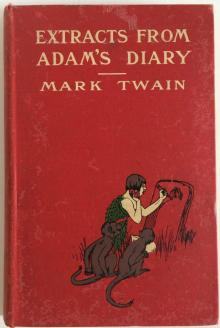 Extracts from Adam's Diary, translated from the original ms.
Extracts from Adam's Diary, translated from the original ms.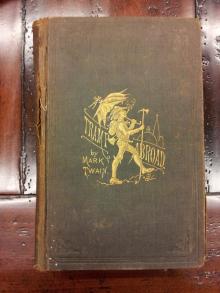 A Tramp Abroad
A Tramp Abroad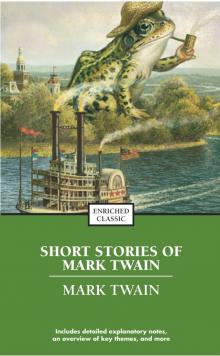 The Best Short Works of Mark Twain
The Best Short Works of Mark Twain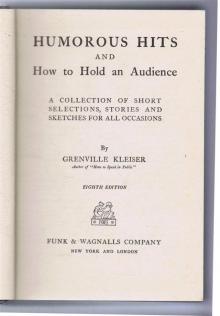 Humorous Hits and How to Hold an Audience
Humorous Hits and How to Hold an Audience The Speculative Fiction of Mark Twain
The Speculative Fiction of Mark Twain The Facts Concerning the Recent Carnival of Crime in Connecticut
The Facts Concerning the Recent Carnival of Crime in Connecticut Alonzo Fitz, and Other Stories
Alonzo Fitz, and Other Stories The $30,000 Bequest, and Other Stories
The $30,000 Bequest, and Other Stories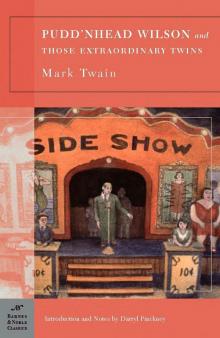 Pudd'nhead Wilson and Those Extraordinary Twins
Pudd'nhead Wilson and Those Extraordinary Twins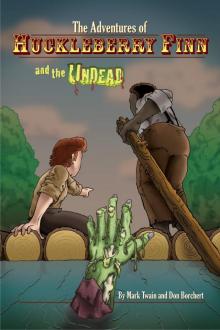 The Adventures of Huckleberry Finn and the Undead
The Adventures of Huckleberry Finn and the Undead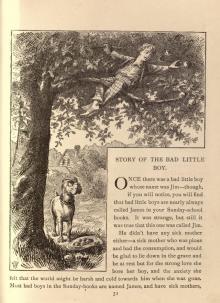 Sketches New and Old
Sketches New and Old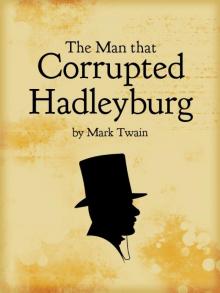 The Man That Corrupted Hadleyburg
The Man That Corrupted Hadleyburg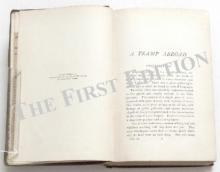 A Tramp Abroad — Volume 06
A Tramp Abroad — Volume 06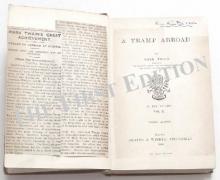 A Tramp Abroad — Volume 02
A Tramp Abroad — Volume 02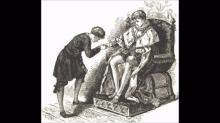 The Prince and the Pauper, Part 1.
The Prince and the Pauper, Part 1. Adventures of Huckleberry Finn, Chapters 16 to 20
Adventures of Huckleberry Finn, Chapters 16 to 20 The Prince and the Pauper, Part 9.
The Prince and the Pauper, Part 9.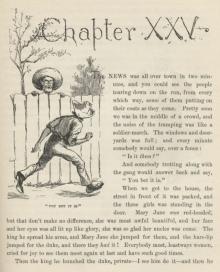 Adventures of Huckleberry Finn, Chapters 21 to 25
Adventures of Huckleberry Finn, Chapters 21 to 25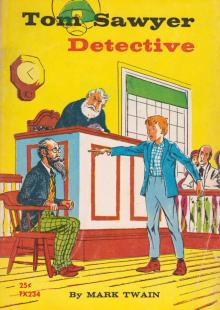 Tom Sawyer, Detective
Tom Sawyer, Detective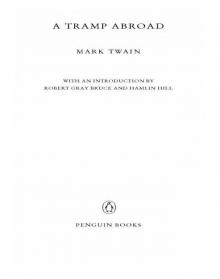 A Tramp Abroad (Penguin ed.)
A Tramp Abroad (Penguin ed.)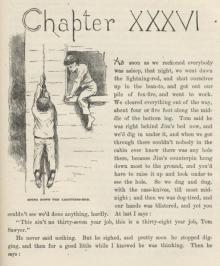 Adventures of Huckleberry Finn, Chapters 36 to the Last
Adventures of Huckleberry Finn, Chapters 36 to the Last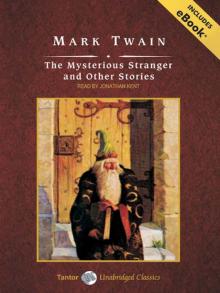 The Mysterious Stranger, and Other Stories
The Mysterious Stranger, and Other Stories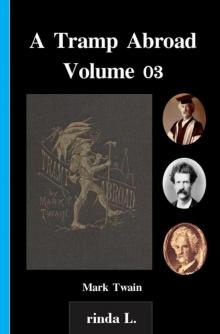 A Tramp Abroad — Volume 03
A Tramp Abroad — Volume 03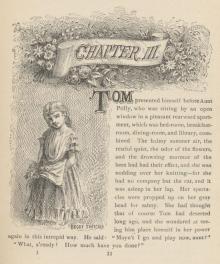 The Adventures of Tom Sawyer, Part 3.
The Adventures of Tom Sawyer, Part 3. Adventures of Huckleberry Finn, Chapters 06 to 10
Adventures of Huckleberry Finn, Chapters 06 to 10_preview.jpg) The Adventures of Huckleberry Finn (Tom Sawyer's Comrade)
The Adventures of Huckleberry Finn (Tom Sawyer's Comrade)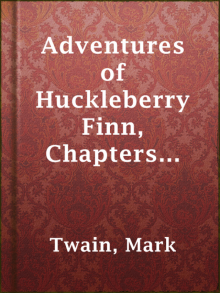 Adventures of Huckleberry Finn, Chapters 31 to 35
Adventures of Huckleberry Finn, Chapters 31 to 35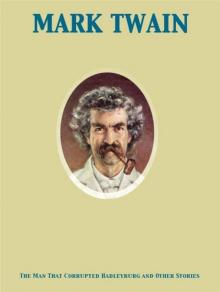 The Man That Corrupted Hadleyburg, and Other Stories
The Man That Corrupted Hadleyburg, and Other Stories A Tramp Abroad — Volume 07
A Tramp Abroad — Volume 07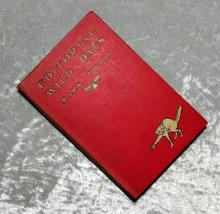 Editorial Wild Oats
Editorial Wild Oats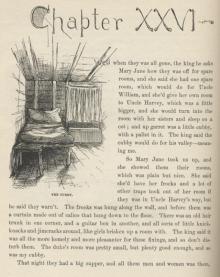 Adventures of Huckleberry Finn, Chapters 26 to 30
Adventures of Huckleberry Finn, Chapters 26 to 30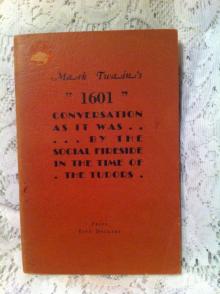 1601: Conversation as it was by the Social Fireside in the Time of the Tudors
1601: Conversation as it was by the Social Fireside in the Time of the Tudors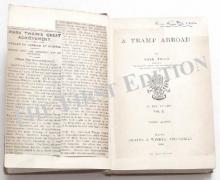 A Tramp Abroad — Volume 05
A Tramp Abroad — Volume 05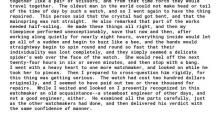 Sketches New and Old, Part 1.
Sketches New and Old, Part 1.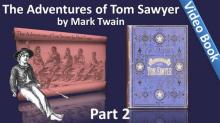 The Adventures of Tom Sawyer, Part 2.
The Adventures of Tom Sawyer, Part 2.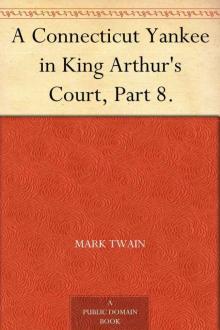 A Connecticut Yankee in King Arthur's Court, Part 8.
A Connecticut Yankee in King Arthur's Court, Part 8. A Tramp Abroad — Volume 01
A Tramp Abroad — Volume 01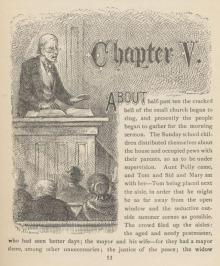 The Adventures of Tom Sawyer, Part 5.
The Adventures of Tom Sawyer, Part 5. Adventures of Huckleberry Finn, Chapters 01 to 05
Adventures of Huckleberry Finn, Chapters 01 to 05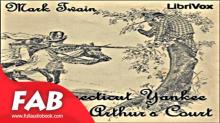 A Connecticut Yankee in King Arthur's Court, Part 1.
A Connecticut Yankee in King Arthur's Court, Part 1.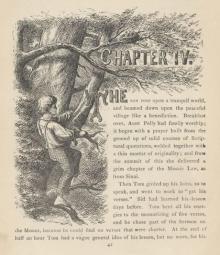 The Adventures of Tom Sawyer, Part 4.
The Adventures of Tom Sawyer, Part 4.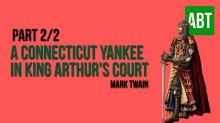 A Connecticut Yankee in King Arthur's Court, Part 2.
A Connecticut Yankee in King Arthur's Court, Part 2.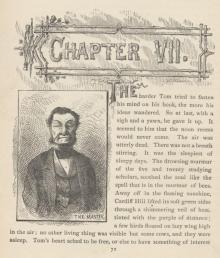 The Adventures of Tom Sawyer, Part 7.
The Adventures of Tom Sawyer, Part 7.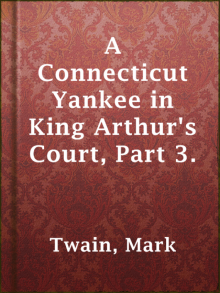 A Connecticut Yankee in King Arthur's Court, Part 3.
A Connecticut Yankee in King Arthur's Court, Part 3.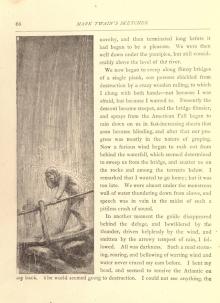 Sketches New and Old, Part 4.
Sketches New and Old, Part 4.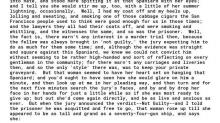 Sketches New and Old, Part 3.
Sketches New and Old, Part 3.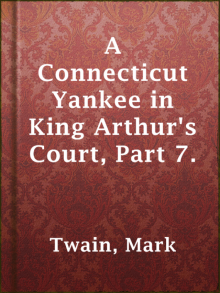 A Connecticut Yankee in King Arthur's Court, Part 7.
A Connecticut Yankee in King Arthur's Court, Part 7. A Connecticut Yankee in King Arthur's Court, Part 5.
A Connecticut Yankee in King Arthur's Court, Part 5.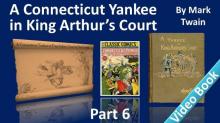 A Connecticut Yankee in King Arthur's Court, Part 6.
A Connecticut Yankee in King Arthur's Court, Part 6.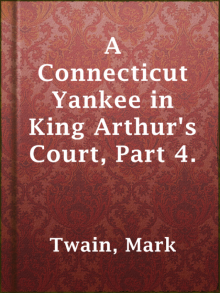 A Connecticut Yankee in King Arthur's Court, Part 4.
A Connecticut Yankee in King Arthur's Court, Part 4. Sketches New and Old, Part 2.
Sketches New and Old, Part 2.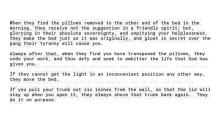 Sketches New and Old, Part 6.
Sketches New and Old, Part 6. Adventures of Huckleberry Finn, Chapters 11 to 15
Adventures of Huckleberry Finn, Chapters 11 to 15 Personal Recollections of Joan of Arc
Personal Recollections of Joan of Arc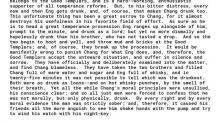 Sketches New and Old, Part 5.
Sketches New and Old, Part 5. Eve's Diary, Part 3
Eve's Diary, Part 3 Sketches New and Old, Part 7.
Sketches New and Old, Part 7.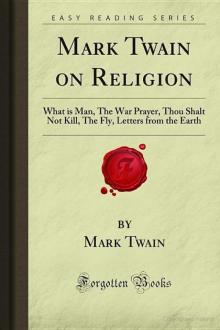 Mark Twain on Religion: What Is Man, the War Prayer, Thou Shalt Not Kill, the Fly, Letters From the Earth
Mark Twain on Religion: What Is Man, the War Prayer, Thou Shalt Not Kill, the Fly, Letters From the Earth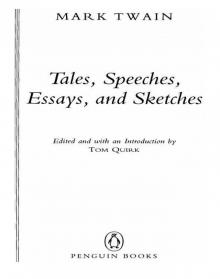 Tales, Speeches, Essays, and Sketches
Tales, Speeches, Essays, and Sketches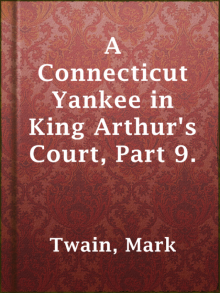 A Connecticut Yankee in King Arthur's Court, Part 9.
A Connecticut Yankee in King Arthur's Court, Part 9.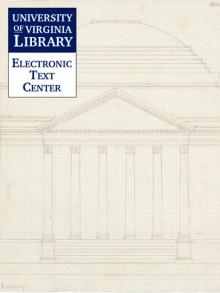 Our Fellow Savages of the Sandwich Islands (version 1)
Our Fellow Savages of the Sandwich Islands (version 1) 1601
1601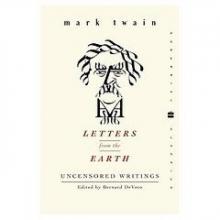 Letters from the Earth
Letters from the Earth Curious Republic Of Gondour, And Other Curious Whimsical Sketches
Curious Republic Of Gondour, And Other Curious Whimsical Sketches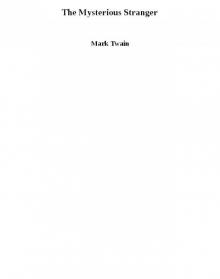 The Mysterious Stranger
The Mysterious Stranger Life on the Mississippi
Life on the Mississippi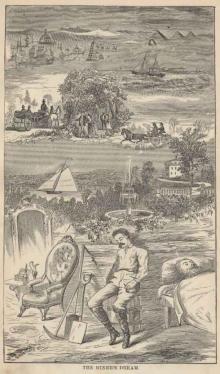 Roughing It
Roughing It Alonzo Fitz and Other Stories
Alonzo Fitz and Other Stories The 30,000 Dollar Bequest and Other Stories
The 30,000 Dollar Bequest and Other Stories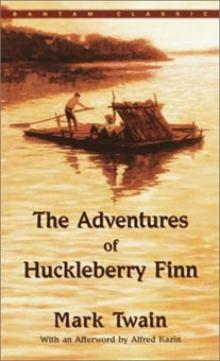 The Adventures of Huckleberry Finn taots-2
The Adventures of Huckleberry Finn taots-2 A Double-Barreled Detective Story
A Double-Barreled Detective Story adam's diary.txt
adam's diary.txt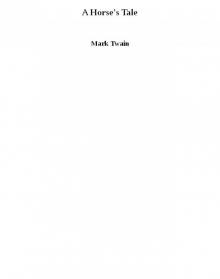 A Horse's Tale
A Horse's Tale Autobiography Of Mark Twain, Volume 1
Autobiography Of Mark Twain, Volume 1 The Comedy of Those Extraordinary Twins
The Comedy of Those Extraordinary Twins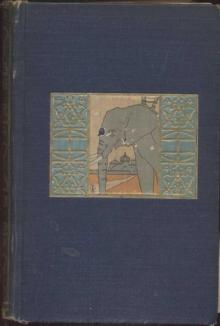 Following the Equator
Following the Equator Goldsmith's Friend Abroad Again
Goldsmith's Friend Abroad Again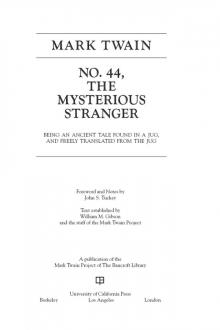 No. 44, The Mysterious Stranger
No. 44, The Mysterious Stranger The Stolen White Elephant
The Stolen White Elephant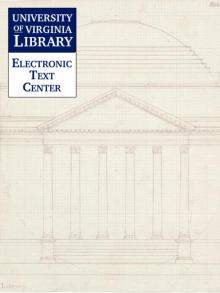 The $30,000 Bequest and Other Stories
The $30,000 Bequest and Other Stories The Curious Republic of Gondour, and Other Whimsical Sketches
The Curious Republic of Gondour, and Other Whimsical Sketches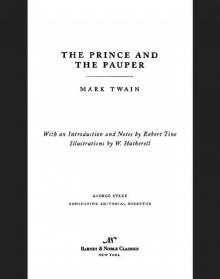 Prince and the Pauper (Barnes & Noble Classics Series)
Prince and the Pauper (Barnes & Noble Classics Series) The Portable Mark Twain
The Portable Mark Twain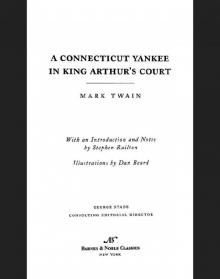 Connecticut Yankee in King Arthur's Court (Barnes & Noble Classics Series)
Connecticut Yankee in King Arthur's Court (Barnes & Noble Classics Series) The Adventures of Tom Sawyer taots-1
The Adventures of Tom Sawyer taots-1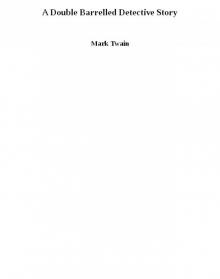 A Double Barrelled Detective Story
A Double Barrelled Detective Story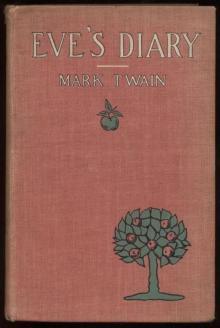 Eve's Diary
Eve's Diary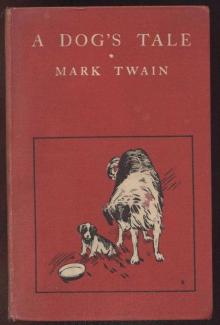 A Dog's Tale
A Dog's Tale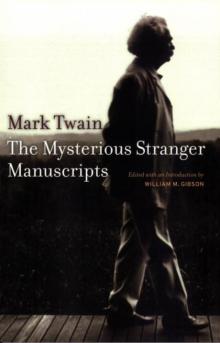 The Mysterious Stranger Manuscripts (Literature)
The Mysterious Stranger Manuscripts (Literature)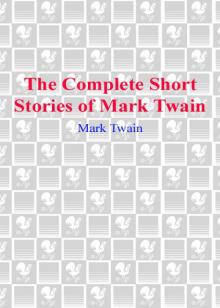 The Complete Short Stories of Mark Twain
The Complete Short Stories of Mark Twain What Is Man? and Other Essays
What Is Man? and Other Essays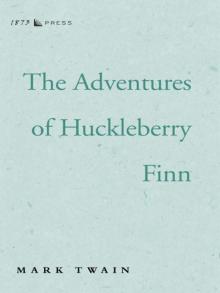 The Adventures of Huckleberry Finn
The Adventures of Huckleberry Finn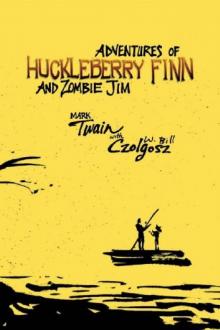 Adventures of Huckleberry Finn and Zombie Jim
Adventures of Huckleberry Finn and Zombie Jim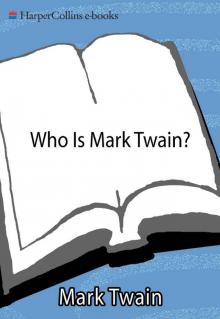 Who Is Mark Twain?
Who Is Mark Twain? Christian Science
Christian Science The Innocents Abroad
The Innocents Abroad Some Rambling Notes of an Idle Excursion
Some Rambling Notes of an Idle Excursion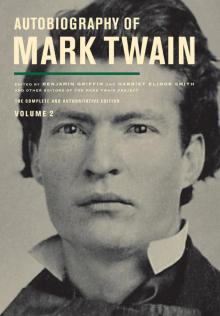 Autobiography of Mark Twain
Autobiography of Mark Twain Those Extraordinary Twins
Those Extraordinary Twins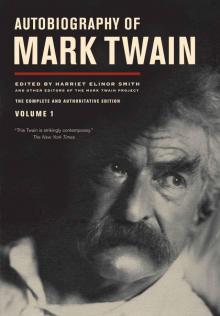 Autobiography of Mark Twain: The Complete and Authoritative Edition, Volume 1
Autobiography of Mark Twain: The Complete and Authoritative Edition, Volume 1